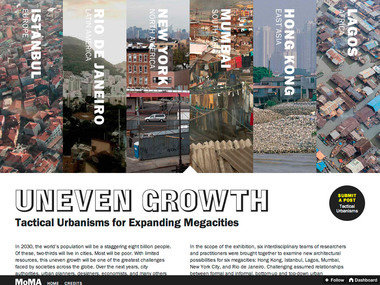Uneven Growth
dal 18/11/2014 al 9/5/2015
Segnalato da
18/11/2014
Uneven Growth
The Museum of Modern Art - MoMA, New York
The show is the third in a series of exhibitions at MoMA called Issues in Contemporary Architecture, which focuses on timely topics in contemporary architecture, with an emphasis on the urban dimension, in order to increase public dialogue about critical issues in architecture.

Uneven Growth: Tactical Urbanisms for Expanding
Megacities, a 14-month initiative to examine new architectural possibilities that address the rapid
and uneven growth of six global metropolises—Hong Kong, Istanbul, Lagos, Mumbai, New York,
and Rio de Janeiro—culminates in an exhibition at The Museum of Modern Art from November 22,
2014, through May 10, 2015. In recent years, tactical modes of urbanism have arisen in the form
of everyday, bottom-up approaches to local problems as a counterpart to a classic notion of top-
down planning. Uneven Growth asks how current practices of architecture and urban design can
learn from such developments by presenting design scenarios based on this type of urbanism,
while also mapping emergent modes of tactical urbanism around the globe. The exhibition
features design visions comprised of drawings, renderings, animations, and videos produced by
six interdisciplinary teams of local practitioners and international architecture and urbanism
experts, each focusing on a specific city. Uneven Growth is organized by Pedro Gadanho, Curator,
Department of Architecture and Design, in collaboration with the Austrian Museum of Applied Arts
(MAK), Vienna.
Tactical urbanism is a highly pragmatic movement that applies to a spectrum of designers,
from those who perform guerilla interventions of short-term change to those who seek to prod,
provoke, or stimulate the political process toward incremental realization of fragments of what
might be larger networks. To further explore these ideas, the Museum has published a book and
created a user-generated Tumblr blog that collects examples of emerging modes of tactical
urbanism happening in the six cities.
Mr. Gadanho states: “The exhibition features design scenarios for future developments
that simultaneously raise awareness of the prevailing inequalities in specific urban areas and
confront the changing roles of architects vis-à-vis ever-increasing urbanization. Each team in the
exhibition was asked to consider how emergent forms of tactical urbanism can respond to
alterations in the nature of public space, housing, mobility, spatial justice, environmental
conditions, and other major issues in near-future urban contexts.
”For the workshop phase of Uneven Growth, six interdisciplinary teams of international
architecture and urbanism practitioners and experts studied megacities in diverse world regions.
The choice of these urban conglomerations was determined by the way in which they display
different degrees, stages, and conditions of urban inequality. Because of the scope of problems
presented by each of these specific urban conditions, each team included participants who have
an intimate knowledge of local circumstances and are embedded in their object of study. Experts
in urban studies at an international level where brought in to provide a collaborative,
transgeographical design chemistry that could respond adequately to the complexities of the
themes.
Following an initial workshop at MoMA PS1 and subsequent workshops at The Value
Factory in Shenzhen, China, and at MAK in Vienna, the collaborating teams produced responses to
the theme and developed new projects under the curatorial and critical guidance of MoMA’s
Department of Architecture and Design and an advisory board that includes Saskia Sassen, David
Harvey, Ricky Burdett, Neil Brenner, Nader Tehrani, Michael Sorkin, Marc Angélil, and Teddy Cruz.
Uneven Growth confronts the global threats of accelerated income discrepancy and a
polarization of wealth and poverty that are manifesting in various ways due to rapid urbanization.
The exhibition is a laboratory experiment devoted not only to bettering life in the expanding city,
but also to defining an effective, activist role for architects in the wake of two generations of
disinvestment in public projects from housing to urban infrastructure. The design scenarios
presented in Uneven Growth counteract the dystopian outcomes that can be expected of the
progression of current urban trends, both in terms of spatial segregation and of socioeconomic
inequality. Even if offering only acupunctural outlooks on how to change for the better, they
present visions that are intended to advance public discussion and suggest models to be applied
to diverse urban contexts.
Uneven Growth is the third in a series of exhibitions at MoMA called Issues in
Contemporary Architecture, which focuses on timely topics in contemporary architecture, with an
emphasis on the urban dimension, in order to increase public dialogue about critical issues in
architecture. The series was launched in 2009 with Rising Currents: Projects for New York's
Waterfront, a major initiative that brought together teams of architects, engineers, and landscape
designers to instigate a debate on New York City’s relationship to sea level rise and to provide
ideas and images that might help activate debate for the millions of people worldwide living in
floodable zones. In 2011, Foreclosed: Rehousing the American Dream used the same approach to
address the challenges of the urban fringe of five American cities that were hard hit by the
subprime mortgage crisis and the tsunami of foreclosures that came in its wake
Press Contact:
Meg Montgoris, (212) 708-9757, meg_montgoris@moma.org
Press Viewing: Wednesday, November 19, 9:30–10:30 a.m.
The Museum of Modern Art - MoMA 11 West 53
Hours: Saturday through Thursday, 10:30 a.m. – 5:30 p.m.
Friday, 10:30 a.m. – 8:00 p.m.
Museum Admission: $25 adults; $18 seniors



